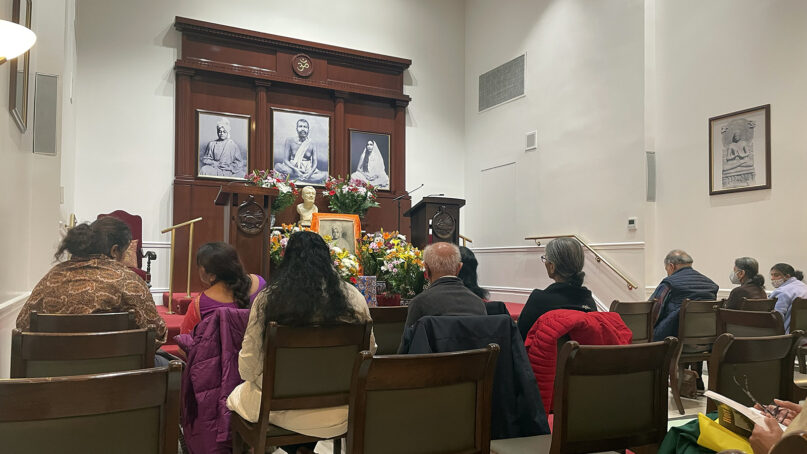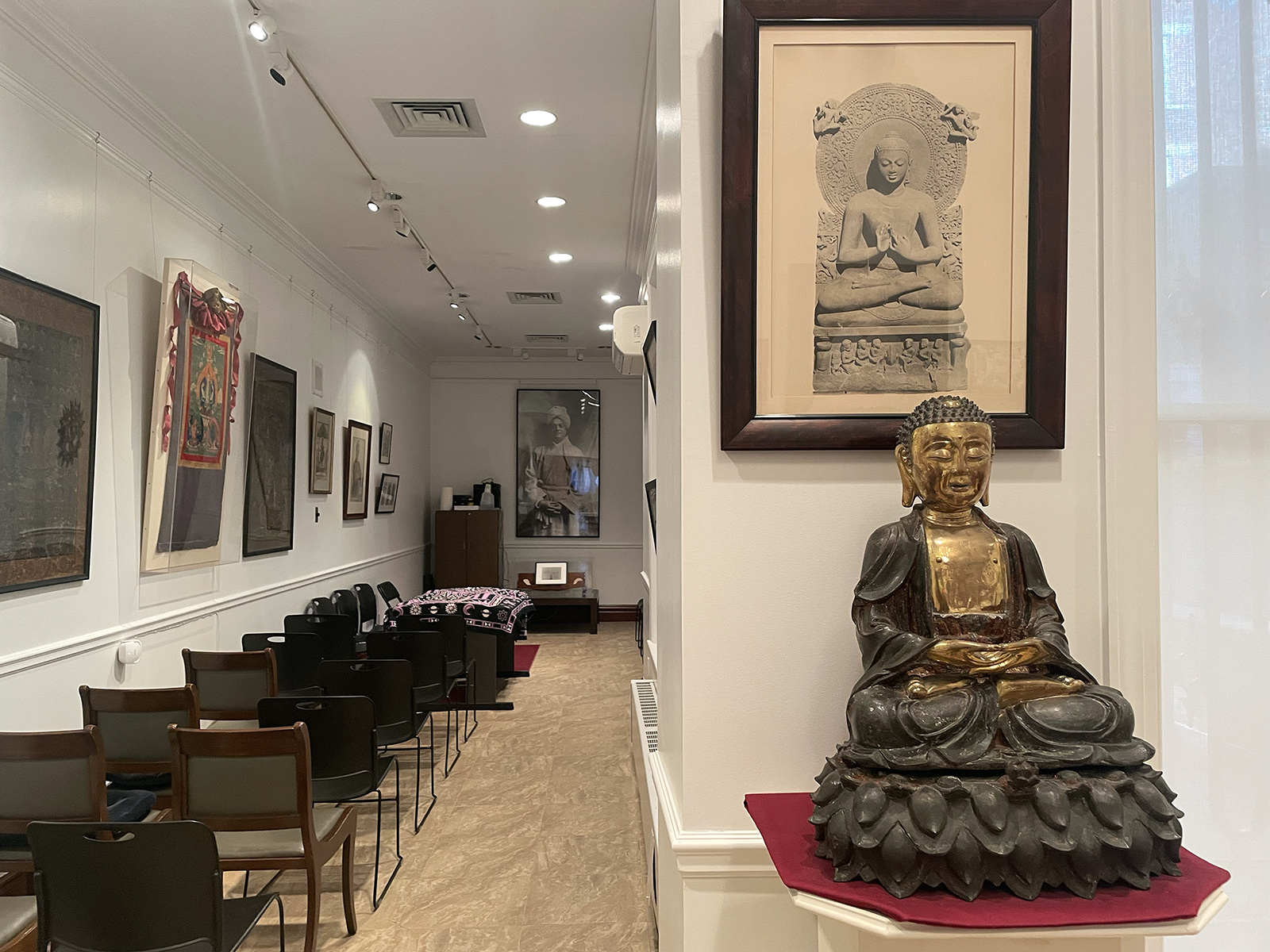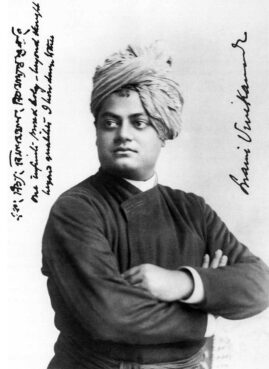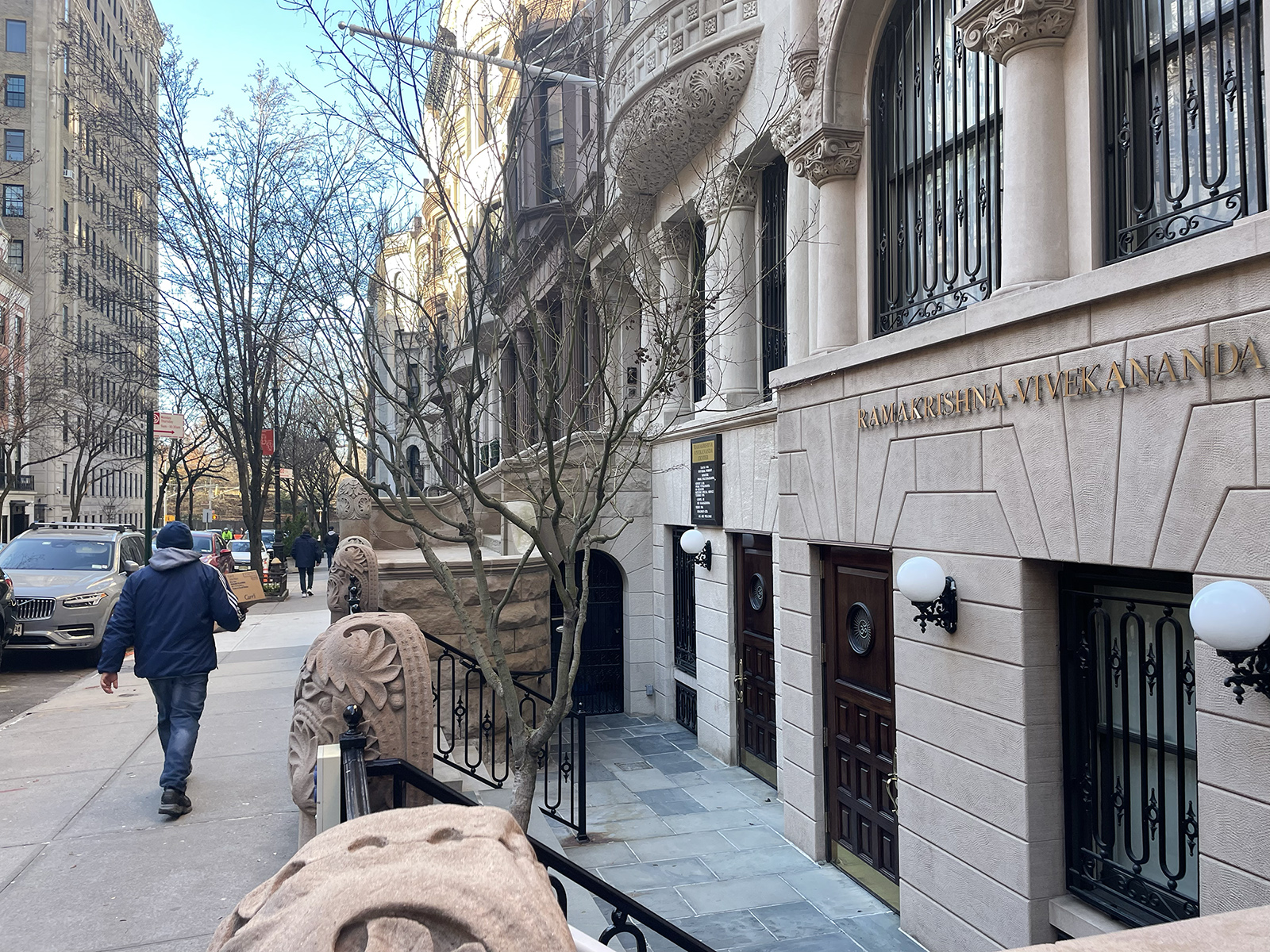As religious conflict and disharmony rage on elsewhere in the world, the interfaith teachings of Swami Vivekananda are evergreen to these devotees.
ONE OF THE SECRET MASTERS OF THE A.A. / O.T.O

People attend a service at the Ramakrishna-Vivekananda Center of New York, Feb. 4, 2024. (RNS photo/Richa Karmarkar)
February 7, 2024
By Richa Karmarkar
NEW YORK (RNS) — At a Sunday morning service on Sunday (Feb. 4), a priest gave a sermon, a choir sang devotional hymns and a congregation bowed heads in a joint prayer.
It was a typical Sunday for these faithful New Yorkers. Yet rather than a church, this service took place at a spiritual home meant for believers under any name, from Christians to Hindus to self-professed “truth-seekers.”
The Ramakrishna-Vivekananda Center of New York, built for the revered Indian monastic who brought the interfaith teachings of Vedantic Hinduism to America and his guru, is the gathering place for devotees of his philosophy, which accepts every faith as a “valid means for its own followers to realize the Truth.”
“Swami Vivekananda redeemed religion for us,” said Swami Yuktatmananda, a monk of the Ramakrishna Order and the current spiritual head of the center, in his sermon. “He made religion real.”
Images of Buddha, Mary and Jesus, and Hindu gods covered the walls of the center’s chapel room, which was started in 1933 by Swami Nikhilananda as a “Vedanta temple for universal worship.” On this special service for Vivekananda’s birthday according to the Hindu calendar, Yuktatmananda was giving a talk about Vivekananda’s views on religion.

A variety of religious imagery adorns the walls of the Ramakrishna-Vivekananda Center of New York, Feb. 4, 2024. (RNS photo/Richa Karmarkar)
“His three most productive years were spent in the United States,” said Yuktatmananda, speaking of the sage’s time sharing philosophies in English with the Western world, translating the “language of angels to the language of man.”
“We are here as a result of his selfless labor,” he added. “He has promised to be with us until the whole world knows it is one with God.”
RELATED: On Vivekananda’s 160th birthday, female monastics venerate the ‘mother’ of his movement
Vivekananda, who lived from 1863-1902, gave dozens of speeches introducing Vedantic spirituality at the turn of the century to audiences across the U.S. and Europe. His speech at the 1893 Parliament of World Religions in Chicago, in which he famously addressed his audience as “Sisters and Brothers of America,” is widely remembered for its preaching on “universal toleration” and the oneness of humanity.
To the devotees at this spiritual sanctuary, the world’s religions are separated only by rituals, dogmas, books and doctrines, which are “secondary, nonessential details,” according to Vivekananda. To him, says Yuktatmananda, the essence of religion is manifesting one’s own innate divine nature, whether it be through Prophet Muhammad, Jesus Christ or Lord Krishna.
“Religion is realization that must be lived, not dispersed,” said the monk, referencing Vivekananda’s teachings. “It is made of tangible experience, not mechanical rituals and theological debates.”

Swami Vivekananda in Chicago during the Parliament of the World’s Religions in September 1893. (Photo courtesy of Creative Commons)
True interfaith harmony, said Vivekananda, is acceptance, not mere tolerance, and seeing both God and one’s self in every person. On World Interfaith Harmony Week, this evergreen message especially resonates with the longtime devotees of the center.
Keith Martinez, a New York native, was raised Roman Catholic. As a freshman in college in the ’80s, Martinez happened across a book that introduced to him Eastern philosophical traditions such as Hinduism and Buddhism. Then a student of physics, concerned with “finding the truth,” Martinez recalls immediately thinking, “Oh my God, this makes so much sense.”
“When you take a step back and learn about another religion, you say, ‘Oh, they’re attempting the same thing,'” said Martinez. “I thought, ‘God is really trying to satisfy the needs of everybody,’ and that’s the way he does it, through these different religions.”
It took just 10 minutes into the first sermon at the Ramakrishna-Vivekananda Center by then-leader Swami Adiswarananda, says Martinez, before he realized this was the path for him. He saw a man who was “speaking from spiritual experience,” he says, unlike the ministers and priests he had known before.
“I believe that a true spiritual man, a true holy person, is meant to come and help,” said Martinez. “As a result, God gives him the right words to say. After all, we are all one, we are all brothers and sisters. These leaders are serving the God that’s within each of us.”
Now a director and choir manager at the center, Martinez played an instrumental part in the opening of the Vivekananda Cottage at Thousand Island Park in upstate New York, where Swami Vivekananda spent seven weeks in meditation.
Martinez credits his friend, mathematician Yogesh Bansal, with bringing him here some 30 years back. The two are still close, attending services together every Sunday.

The Ramakrishna-Vivekananda Center of New York, Feb. 4, 2024.
(RNS photo/Richa Karmarkar)
Bansal, originally from India, says he was once praised by Swami Adiswarananda for bringing the most amount of people to the center from other faiths and cultures. He notes it can be difficult for many, especially those raised in other faith traditions, to grasp such abstract concepts of spirituality, such as worshipping the “inner light” that shines inside everyone.
“These are all ideas and concepts, but you have to genuinely feel that ‘Yes, Muhammad is also God,'” said Bansal. “How does that happen? That happens when you see God within yourself.
“The point is how you feel within, and how your heart and mind rushes toward God,” he added.
Diana Cooper, a retired nurse, found the center after walking past it one day. A cradle Catholic, Cooper was seeking more, traveling through Jainism to reach the Vedanta tradition, which she calls “the real deal.” In coming for the past 20 years, Cooper says she has realized more and more that “we are all souls.”
“There are other God men. It’s not just Ramakrishna, it’s not just Buddha, it’s not just Christ. Many come at different times,” she said. “This whole place is the oneness of religion.”
Cooper agrees with Bansal that where and when someone was raised has the highest impact on their beliefs. But it is up to us, she says, to eliminate the “us versus them” mentality between religious groups and start to see each person’s journey as leading to the same God.
“Nobody has the exact same karma, so every road is going to be a little bit different,” she said. “Everybody has their path. For me, this is it.”
For Mansi Mehta, the path to Vivekananda was forged at age 7. A singer in the choir and humanitarian worker, 36-year-old Mehta says the swami’s words have been the “guiding force” behind her decision-making for all of these years. The teachings about the world, she says, remind her there is always something bigger than herself.
“No matter what path we’re on, whether it’s an actual religion or our own path, at the end of the day it’s supposed to lead to the same goal,” she said. “There’s no right or wrong religion, it’s just a belief, and it’s a feeling within ourselves.”
As the service ended with a prayer, salutations were given to “all the prophets of the past and the future.” And the choir sang a rendition of Vivekananda follower George Harrison’s “My Sweet Lord,” emphasizing the Hebrew word of praise “Hallelujah” and the Hindu mantra of “Hare Rama, Hare Krishna.”
To Martinez, the spirituality he found through Vivekananda is the key to unlocking harmony across the world, especially as religious conflict and intolerance rage on.
“It’s always gonna be an individual thing,” he said. “Each person has to make a difference. As Michael Jackson says, it starts with the man in the mirror.”
Bansal, originally from India, says he was once praised by Swami Adiswarananda for bringing the most amount of people to the center from other faiths and cultures. He notes it can be difficult for many, especially those raised in other faith traditions, to grasp such abstract concepts of spirituality, such as worshipping the “inner light” that shines inside everyone.
“These are all ideas and concepts, but you have to genuinely feel that ‘Yes, Muhammad is also God,'” said Bansal. “How does that happen? That happens when you see God within yourself.
“The point is how you feel within, and how your heart and mind rushes toward God,” he added.
Diana Cooper, a retired nurse, found the center after walking past it one day. A cradle Catholic, Cooper was seeking more, traveling through Jainism to reach the Vedanta tradition, which she calls “the real deal.” In coming for the past 20 years, Cooper says she has realized more and more that “we are all souls.”
“There are other God men. It’s not just Ramakrishna, it’s not just Buddha, it’s not just Christ. Many come at different times,” she said. “This whole place is the oneness of religion.”
Cooper agrees with Bansal that where and when someone was raised has the highest impact on their beliefs. But it is up to us, she says, to eliminate the “us versus them” mentality between religious groups and start to see each person’s journey as leading to the same God.
“Nobody has the exact same karma, so every road is going to be a little bit different,” she said. “Everybody has their path. For me, this is it.”
For Mansi Mehta, the path to Vivekananda was forged at age 7. A singer in the choir and humanitarian worker, 36-year-old Mehta says the swami’s words have been the “guiding force” behind her decision-making for all of these years. The teachings about the world, she says, remind her there is always something bigger than herself.
“No matter what path we’re on, whether it’s an actual religion or our own path, at the end of the day it’s supposed to lead to the same goal,” she said. “There’s no right or wrong religion, it’s just a belief, and it’s a feeling within ourselves.”
As the service ended with a prayer, salutations were given to “all the prophets of the past and the future.” And the choir sang a rendition of Vivekananda follower George Harrison’s “My Sweet Lord,” emphasizing the Hebrew word of praise “Hallelujah” and the Hindu mantra of “Hare Rama, Hare Krishna.”
To Martinez, the spirituality he found through Vivekananda is the key to unlocking harmony across the world, especially as religious conflict and intolerance rage on.
“It’s always gonna be an individual thing,” he said. “Each person has to make a difference. As Michael Jackson says, it starts with the man in the mirror.”
No comments:
Post a Comment